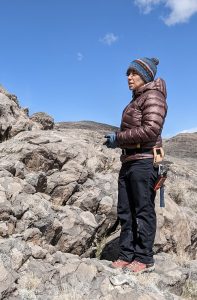 I am a paleobiologist; my research is broadly focused on the interactions between Earth and life in deep time. I interrogate the fossil record through taxonomy, as well as through approaches that reveal additional layers of information and connect the fossil record to other parts of the earth system. My research involves a combination of field and lab work coupled with microscopy and microanalytical techniques.
I am a paleobiologist; my research is broadly focused on the interactions between Earth and life in deep time. I interrogate the fossil record through taxonomy, as well as through approaches that reveal additional layers of information and connect the fossil record to other parts of the earth system. My research involves a combination of field and lab work coupled with microscopy and microanalytical techniques.
Proterozoic Paleobiology & Geobiology:
My first research goal investigates eukaryotic evolution in the Proterozoic Eon which lasted from 2500 million years ago (Ma) to 543 Ma. This time period is a critical area of inquiry in paleobiology because it immediately precedes the Cambrian Radiation and the Phanerozoic (visible life) Eon, where nearly all animal phyla appear in the fossil record. Thus, even though the Phanerozoic is where animal life rises to ecological dominance, the roots of animal origins, and the evolution and radiation of the eukaryotic clade as a whole, lay within the Proterozoic. In addition, these biotic events occurred against a backdrop of dramatically changing climactic and oceanographic conditions — including increased levels of oxygen, changing geochemical conditions, and at least two “Snowball Earth” events where the entire globe was encased in ice. In my research, I seek to reconstruct the interplay between these biotic and abiotic events in the Proterozoic by integrating data from the fossil record, the rock record, geochemical proxies, and modern phylogenetics and physiology. Most of this work focuses on single-celled fossils of eukaryotes (such as amoeba), and much of my field-based work has focused on eukaryotic fossils from before the first “Snowball Earth” event. The goal of this research is to better understand how complex life evolved in concert with the rest of the earth system.
The Paleozoic Microfossil Record:
The second goal of my work is to better understand what the organic-walled microfossil record of the Proterozoic Eon and Phanerozoic Era (541 Ma – 251 Ma) can tell us about evolutionary and environmental change. Organic-walled microfossils (OWMs) are microscopic, close-walled fossils made of recalcitrant organic material. They likely represent structures made by a variety of eukaryotic organisms. They are abundant and diverse for much of the Proterozoic and Paleozoic, after which point they experience a significant decline. Many OWM forms are poorly understood. We often do not know what kinds of organisms made these structures, why they form them, or how preservational processes affects their diversity and abundance in the fossil record. Despite these issues, OWMs are often used to interpret patterns in deep time such as overall biological diversity and marine primary productivity. By studying the fossil record in concert with study of similar structures made by modern groups, I try to find ways to better interpret the record of OWMs. This work will enable us to fully utilize the OWM record to make interpretations about critical earth history events such as extinctions and changing ecosystem dynamics.
The newest branch of this second goal has been my work on the Late Devonian extinction event. The Late Devonian was a time of highly elevated biodiversity loss, turnover, and ecological restructuring. The largest pulse of Late Devonian extinctions occurs at the Frasnian-Fammenian (F-F) boundary. The cause of the F-F extinctions are poorly understood and remain a topic of some controversy, but it is widely believed that low oxygen conditions played a role. Although an extinction in the marine invertebrate fossil record is well documented, less research has been done to understand the record of OWMs both in terms of their diversity and their paleoenvironmental significance in light of data suggesting lowered oxygen levels during these intervals. Thus, OWM represent an underutilized window into our understanding of the Late Devonian biodiversity crisis. My research project seeks to use OWMs to investigate the cause and consequences of the End-Devonian extinction as well as to better understand the taxonomic affinity of enigmatic OWMs. The significance of this project is broad because if we are successful in using OWMs as a new extinction proxy, then we can potentially apply this approach to other intervals of earth history.
Recent Publications:
Check out my Google Scholar Profile for links to publications
For more information, see my CV
Press about my work:
Williams College website / alumni magazine
